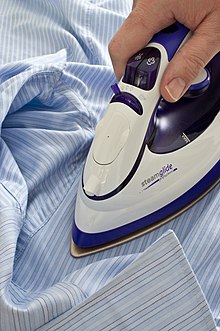
Ironing is the use of an iron, usually heated, to remove wrinkles and unwanted creases from fabric.[1] The heating is commonly done to a temperature of 180–220 °C (360–430 °F), depending on the fabric.[2] Ironing works by loosening the bonds between the long-chain polymer molecules in the fibres of the material. While the molecules are hot, the fibres are straightened by the weight of the iron, and they hold their new shape as they cool. Some fabrics, such as cotton, require the addition of water to loosen the intermolecular bonds. Many modern fabrics (developed in or after the mid-twentieth century) are advertised as needing little or no ironing. Permanent press clothing was developed to reduce the ironing necessary by combining wrinkle-resistant polyester with cotton.[3]
The first known use of heated metal to "iron" clothes is known to have occurred in China.[4] The electric iron was invented in 1882, by Henry Seely White. Seely patented his "electric flatiron" on June 6, 1882 (U.S. Patent no. 259,054).[5]
- ^ "Ironing". The Free Dictionary By Farlex. Retrieved 2012-05-24.
- ^ Cite error: The named reference
Ullmannwas invoked but never defined (see the help page). - ^ "IRONING definition". linguazza.com. Retrieved 2022-07-12.
- ^ Oldandinteresting.com
- ^ Enchantedlearning.com